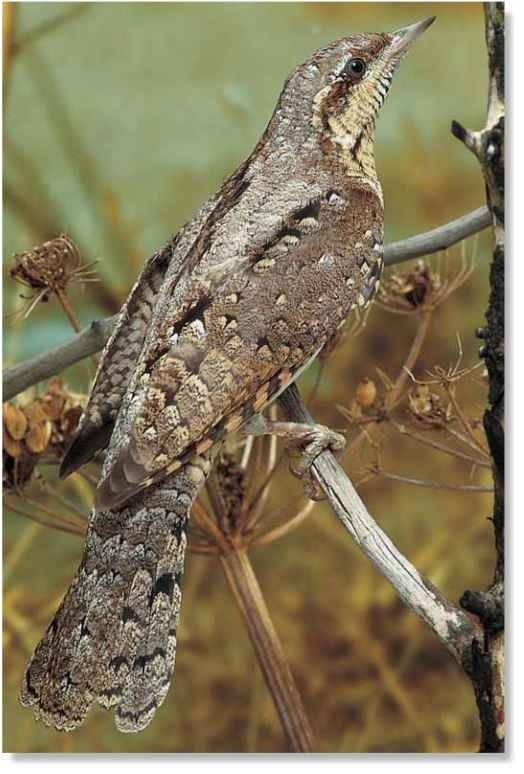ORDER
Piciformes
FAMILY
Picidae
GENUS & SPECIES
KEY FEATURES
• Hunts by digging into anthills with its bill, and by licking ants off trees and the ground with its long, threadlike tongue
• Has a highly flexible neck; can turn its head almost 180°
• Plumage is patterned with delicate brown and gray markings, which provide superb camouflage against the trees and branches in its woodland home
WHERE IN THE WORLD?
Breeds across Europe and north-central Asia, from Iberia east to Japan, with small populations in North Africa, the Himalayas and china; migrates to sub-Saharan Africa and southern Asia for winter
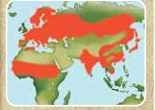
LIFECYCLE
The wryneck is perfectly adapted to woodland life. Feeding mostly on ants, it breaks open their mounds to induce them to emerge, and then snaps them up by the hundreds.
HABITAT
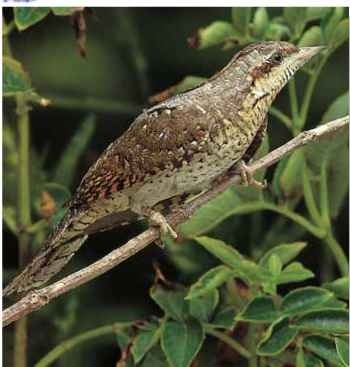
A Low-level hunter The wryneck favors branches near the ground.
The wryneck is common in lightly wooded habitats with warm, sandy soils that house healthy numbers of ants. Ants
and the wryneck — flourish in woodland clearings, scrub, orchards, parks and riverside trees, along the edges of woods and on heathland. Strongly favoring a continental climate, the wryneck prefers lowland, deciduous woodland and shuns dense forest, although it occurs in coniferous forests in northern parts of its range.
As the air temperature drops, ants die or retreat underground, depriving the wryneck of its primary food. By the end of August, the wryneck deserts its summer home and flies to its wintering grounds. Birds from Europe and western Russia spend the winter on the grasslands of tropical Africa, while those from central and northern Asia migrate to the Indian subcontinent and Southeast Asia.The wryneck returns north between March and May
FOOD & FEEDING
The wryneck feeds on ants at every stage of their lifecycle, from eggs, grubs and pupae to flightless worker ants and fully winged adults. The bird favors ant species that build yard-high anthills housing 1 thousands of ants each, so it can eat its fill once it has 1 breached the anthill. At other times, the wryneck waits beside trails of moving ants, licking them up as they march by.
The wryneck boosts its diet with beetles, grasshoppers, spiders, woodlice, flies and moths taken from leaf litter and branches. It seldom ventures into the treetops when foraging, preferring to stay nearer the ground where the mainstay of its diet is found.
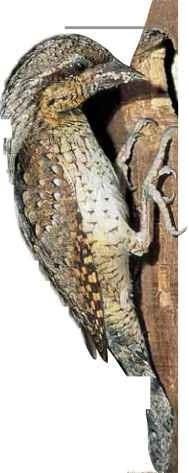
Picky A wryneck gathers beakfuls of insects and takes them back to feed to its young.
FORAGING ANTICS
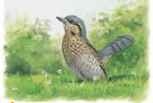
Jerky gait…
A wryneck hops around the woodland floor in search of a new anthill. It moves clumsily on flat ground, with its tail raised.

Break-in…
With a few hammer blows from its bill, the wryneck breaks into the nest.Ants swarm out, like lambs to the slaughter.
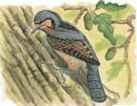
Hidden secrets…
The wryneck flies to an oak tree, gripping the rough bark with its strong feet. It looks in holes in the bark for grubs and food items.
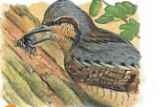
Juicy reward
The wryneck detects the tiny sound of a beetle moving behind the bark, and swiftly inserts its long tongue to catch the insect.
The wryneck often collects indigestible fragments, such as shells, stones and bones, and feeds them to its young to provide them with extra minerals.
During migration, the wryneck often turns up in suburban gardens, desperate for a quick meal.
The wryneck can hold 150 ants in its throat at any one time; 0.5 cu. inch of its feces may contain the remains of up to 800 ants.
BREEDING
In late spring, the male wryneck announces himself by delivering a shrill song. It is very loud for a relatively small bird, and sounds rather like a falcon. If the male encounters a rival on his territory, he stretches out and points his bill, while raising his crest feathers.
During the courtship display, male and female perch face to face, shaking their heads and rolling their shoulders. Aggressive toward other hole-nesting birds, the pair often usurps the nest of another species and evicts thec original residents.The female lays a single clutch of 7-10 eggs, and both parents share incubation duties.
The chicks hatch about two weeks later. At first, the adults clamber inside the nest hole to feed their offspring almost solely on insects and larvae, but when the growing brood begins to fill the entire nest space, they are forced to perch at the entrance. Within three weeks, the young wrynecks have left the safety of the nest.
Neck of the woods When selecting a nest hole, the wryneck inspects nearby cavities and often evicts other hole-nesting birds.
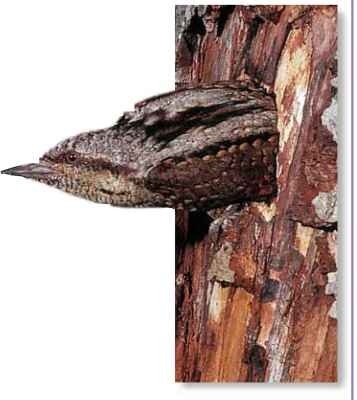
BEHAVIOR
The wryneck is normally solitary, although groups of up to 20 may gather at rich hunting grounds.
Confident of its camouflaging plumage, the wryneck does not flee at the first sign of danger. When it detects a predator, such as a stoat, weasel or bird of prey, it flattens itself against a branch and melts from sight. If out in the open, it also crouches and has even been known to feign death, hanging limp with its eyes closed, to fool a predator.
Color code The wryneck’s coat provides exceptional camouflage in the forest.
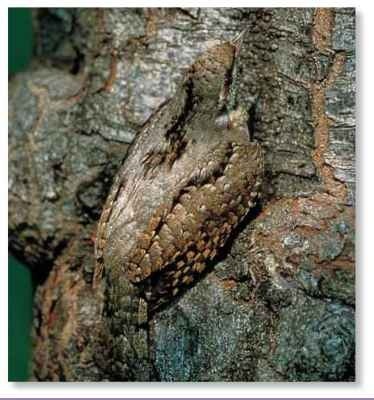
CONSERVATION
Across most of their range, wryneck populations are stable. However, the species has suffered a significant decline in northwestern Europe, particularly in Britain.The wryneck could be seen throughout Britain until the middle of the 19th century, but by the 1950s, it was almost extinct in England and Wales. Its decline may be the result of climate change, but a rise in pesticide use over the last few decades has not helped.Today, only a handful of pairs breeds in the Scottish Highlands.
Profile
Wryneck
The wryneck’s patterned plumage conceals the bird so well in woodland areas that the only clue to its presence is the rapid twisting of its head.
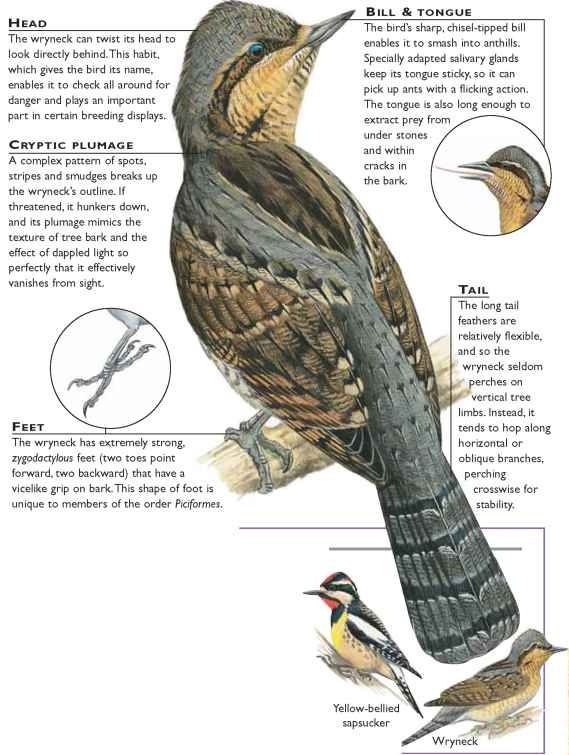
CREATURE COMPARISONS
The yellow-bellied sapsucker (Sphyrapicus varius) has a bright plumage of crimson, canary yellow, black and white. Stockier than the wryneck the sapsucker has a heavier bill, thickset neck and stiffened tail feathers to use as a prop when climbing up tree trunks.
Both birds are long-haul migrants.The sapsucker lives in deciduous forest and breeds in central and northern North America, wintering in the southern U.S. states and in Central America. It feeds by drilling evenly spaced rows of holes in trees and then returning later to drink the oozing sap.
| VITAL STATISTICS | |
| Weight | 1-1.5 oz. |
| Length | 6.4-6.8″ |
| Wingspan | 10-11″ |
| Sexual Maturity | 1 year |
| Breeding Season | Late April -August |
| Number of Eggs | 7-10 per clutch |
| Incubation Period | 11-14 days |
| Fledging Period | 8-22 days |
| Breeding Interval | 2 broods af,’ year |
| Typical Diet | Ants, beetles, grasshoppers and other insects; spiders |
| Lifespan | Oldest tagged bird: 10 years |
RELATED SPECIES
• There are about 200 species in the woodpecker family, Picidae, which is divided into 3 subfamilies: Jynginae contains a single genus, Jynx; the wryneck and red-breasted wryneck are its only members. Picinae has about 170 true woodpeckers, and Picumninae has 29 j species of piculet. Close relatives of woodpeckers include the toucans, honeyguides, jacamars, puffbirds and barbets.
